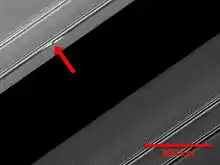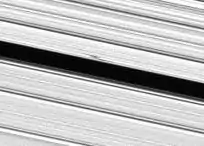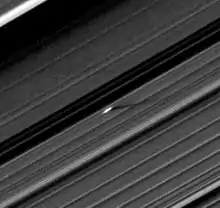Moonlet
A moonlet, minor moon, minor natural satellite, or minor satellite is a particularly small natural satellite orbiting a planet, dwarf planet, or other minor planet.

Another image of Earhart
.jpg.webp)
Another moonlet named Bleriot
A moonlet named Santos-Dumont

A moonlet in Saturn's A ring.
Up until 1995, moonlets were only hypothetical components of Saturn's F-ring structure, when the Earth passed through Saturn's ring plane. The Hubble Space Telescope and the European Southern Observatory both captured objects orbiting close or near the F-ring. In 2004, Cassini caught an object 4-5km in diameter on the outer ring of the F-ring and then 5 hours later on the inner F-ring, showing that the object had orbited.[1]
Three different types of small moons have been called moonlets:
- A belt of objects embedded in a planetary ring, especially around Saturn, such as those in the A Ring, S/2009 S 1 in the B Ring ("propeller" moonlets),[2][3] and those in the F Ring[4]
- Occasionally asteroid moons, such as those of 87 Sylvia[5]
- Flashes seen near Jupiter's moon Amalthea that is likely debris ejected from its surface
- Subsatellites[6]
See also
| Look up moonlet in Wiktionary, the free dictionary. |
References
- O.C. Winter; et al. (2007). "Moonlets wandering on a leash-ring". Monthly Notices of the Royal Astronomical Society. 380 (1): L54–L57. doi:10.1111/j.1745-3933.2007.00347.x.
- Matthew S. Tiscareno; et al. (2006). "100-metre-diameter moonlets in Saturn's A ring from observations of 'propeller' structures". Nature. 440 (7084): 648–650. Bibcode:2006Natur.440..648T. doi:10.1038/nature04581. PMID 16572165.
- Miodrag Sremčević; et al. (2007). "A belt of moonlets in Saturn's A ring". Nature. 449 (7165): 1019–1021. Bibcode:2007Natur.449.1019S. doi:10.1038/nature06224. PMID 17960236.
- Carl D. Murray; et al. (June 5, 2008). "The determination of the structure of Saturn's F ring by nearby moonlets". Nature. The Science and Technology Facilities Council. 453 (7196): 739–44. Bibcode:2008Natur.453..739M. doi:10.1038/nature06999. PMID 18528389. Archived from the original on December 23, 2012.
- F. Marchis; et al. (2005). "Discovery of the triple asteroidal system 87 Sylvia". Nature. 436 (7052): 822–24. Bibcode:2005Natur.436..822M. doi:10.1038/nature04018. PMID 16094362.
- Robert Walker (17 April 2015). "Can Moons Have Moonlets? Or Rings? Moonlets Of Pluto's Moons?". Science 2.0. Retrieved 9 April 2016.
Further reading
This article is issued from Wikipedia. The text is licensed under Creative Commons - Attribution - Sharealike. Additional terms may apply for the media files.
